Related Research Articles

The Apostolic Palace is the official residence of the Pope, the head of the Catholic Church, located in Vatican City. It is also known as the Papal Palace, the Palace of the Vatican and the Vatican Palace. The Vatican itself refers to the building as the Palace of Sixtus V, in honor of Pope Sixtus V, who built most of the present form of the palace.
A prisoner in the Vatican or prisoner of the Vatican described the situation of the pope with respect to the Kingdom of Italy during the period from the capture of Rome by the Royal Italian Army on 20 September 1870 until the Lateran Treaty of 11 February 1929. Part of the process of the unification of Italy, the city's capture ended the millennium-old temporal rule of the popes over Central Italy and allowed Rome to be designated the capital of the new nation. Although the Italians did not occupy the territories of Vatican Hill delimited by the Leonine walls and offered the creation of a city-state in the area, the popes from Pius IX to Pius XI refused the proposal and described themselves as prisoners of the new Italian state.
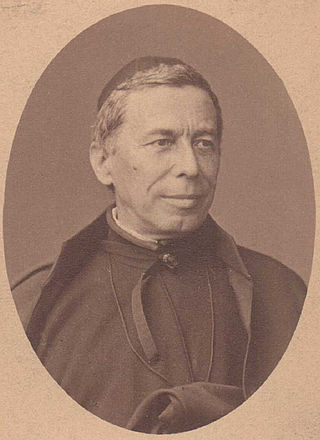
Angelo Secchi was an Italian Catholic priest, astronomer from the Italian region of Emilia. He was director of the observatory at the Pontifical Gregorian University for 28 years. He was a pioneer in astronomical spectroscopy, and was one of the first scientists to state authoritatively that the Sun is a star.

GiacomoBarozzida Vignola, often simply called Vignola, was one of the great Italian architects of 16th century Mannerism. His two great masterpieces are the Villa Farnese at Caprarola and the Jesuits' Church of the Gesù in Rome. The three architects who spread the Italian Renaissance style throughout Western Europe are Vignola, Serlio and Palladio. He is often considered the most important architect in Rome in the Mannerist era.

The Lateran Palace, formally the Apostolic Palace of the Lateran, is an ancient palace of the Roman Empire and later the main papal residence in southeast Rome.
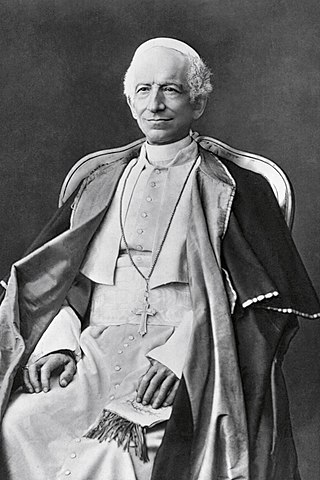
The papal conclave held from 18 to 20 February 1878 saw the election of Vincenzo Pecci, who took the name Leo XIII as pope. Held after the death of Pius IX, who had had the longest pontificate since Saint Peter, it was the first election of a pope who would not rule the Papal States. It was the first to meet in the Apostolic Palace in the Vatican because the venue used earlier in the 19th century, the Quirinal Palace, was now the palace of the king of Italy, Umberto I.
The Agony and the Ecstasy (1961) is a biographical novel of Michelangelo Buonarroti written by American author Irving Stone. Stone lived in Italy for years visiting many of the locations in Rome and Florence, worked in marble quarries, and apprenticed himself to a marble sculptor. A primary source for the novel is Michelangelo's correspondence, all 495 letters of which Stone had translated from Italian by Charles Speroni and published in 1962 as I, Michelangelo, Sculptor. Stone also collaborated with Canadian sculptor Stanley Lewis, who researched Michelangelo's carving technique and tools. The Italian government lauded Stone with several honorary awards for his cultural achievements highlighting Italian history.
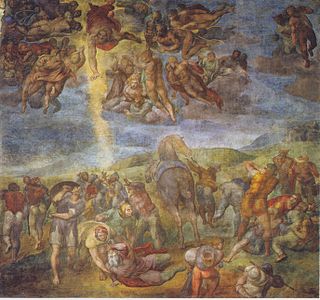
The Cappella Paolina is a chapel in the Apostolic Palace, Vatican City. It is separated from the Sistine Chapel by the Sala Regia. It is not on any of the regular tourist itineraries.

The Minor Basilica of St. Lawrence in Damaso or simply San Lorenzo in Damaso is a parish and titular church in central Rome, Italy that is dedicated to St. Lawrence, deacon and martyr. It is incorporated into the Palazzo della Cancelleria, which enjoys the extraterritoriality of the Holy See.

Angri is a town and comune in the province of Salerno, Campania, southern Italy. It is around 15 miles (24 km) northwest of the town of Salerno.

The Disputation of the Sacrament, or Disputa, is a painting by the Italian Renaissance artist Raphael. It was painted between 1509 and 1510 as the first part of Raphael's commission to decorate with frescoes the rooms that are now known as the Stanze di Raffaello, in the Apostolic Palace in the Vatican. At the time, this room was known as the Stanza della Segnatura, and was the private papal library where the supreme papal tribunal met.
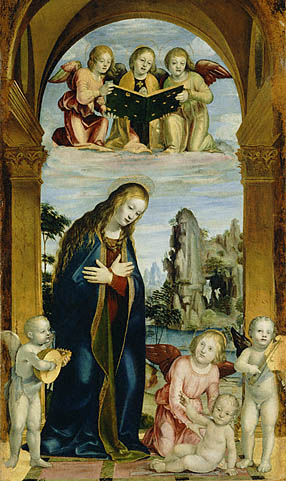
BernardoZenale was an Italian painter and architect.

Alessandro Specchi was an Italian architect and engraver.

The Church of Saint Anne in the Vatican, known as Sant'Anna de' Palafrenieri, is a Catholic parish church dedicated to Saint Anne in Vatican City. The church is the parish church of the State of Vatican City and is placed under the jurisdiction of the Vicariate of the Vatican City and is located beside the Porta Sant'Anna, an international border crossing between Vatican City State and Italy.
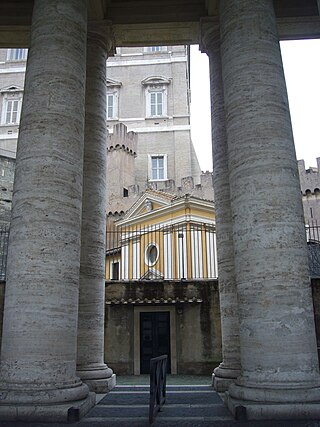
The Church of Saints Martin and Sebastian of the Swiss is a Roman Catholic oratory in Vatican City. The church was built by Pope Pius V in 1568 to serve as a private chapel for the Pontifical Swiss Guards, whose barracks are located next to Porta San Pellegrino, close to the Apostolic Palace. It is considered the national church of Switzerland in Rome.
The church of Sant'Egidio in Borgo, ...a Borgo, or ...in Vaticano, is a Roman Catholic oratory in Vatican City dedicated to Saint Giles.

Pietà is a c. 1600 oil on canvas painting by Annibale Carracci, the earliest surviving work by him on the subject, which was commissioned by Odoardo Farnese. It moved from Rome to Parma to Naples as part of the Farnese collection and is now in the National Museum of Capodimonte in Naples. It is one of many 16th century Bolognese paintings dedicated to the theme of the Pietà, and it is counted among Carracci's masterpieces.

Anna Maria Vaiani was an Italian engraver, who was most known for her botanical engravings and designs.

Via Trionfale is a Roman road that leads to and within Rome, Italy. Formerly called Via Triumphalis, it was an ancient consular road that connected Rome to Veii. The northern terminus of the road connects with the Via Cassia.
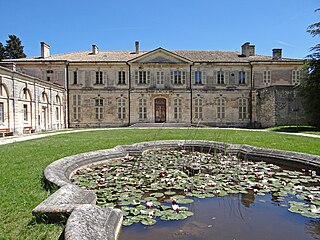
Jean-Baptiste Franque was a French architect. He was the father of François II Franque and Jean-Pierre Franque, also architects, and therefore the father-in-law of the architect Esprit-Joseph Brun.
References
- ↑ Conde, Skip. "Filippo Martinucci" (PDF). Churches of Rome. Retrieved Oct 14, 2019.
- ↑ Tizanni, Vincenzo (24 March 2015). Effemeridi Romane: Volume Primo 1828-1860 (in Italian). Rome: Gangemi Editore spa. p. 1859. ISBN 978-88-492-7615-2 . Retrieved Oct 14, 2019.
- ↑ Massi, H.J. (1885). Compendious Description of the Galleries of Paintings in the Papal Palace of the Vatican. Vatican City. p. 17 . Retrieved Oct 14, 2019.
{{cite book}}: CS1 maint: location missing publisher (link) - ↑ Hare, Augustus John Cuthbert (1905). Walks in Rome. Routledge. p. 533 . Retrieved Oct 14, 2019.
- ↑ Furlan, Alessandro (ed.). Rome Monuments and Memories (PDF). p. 469. Retrieved Oct 14, 2019.